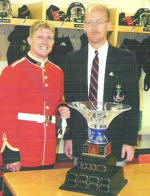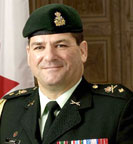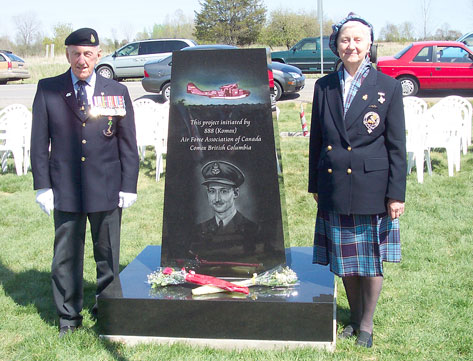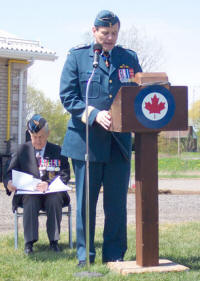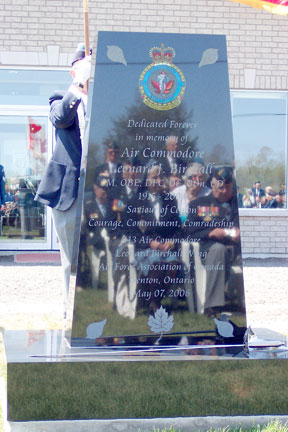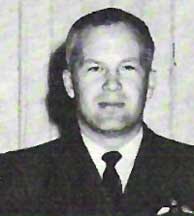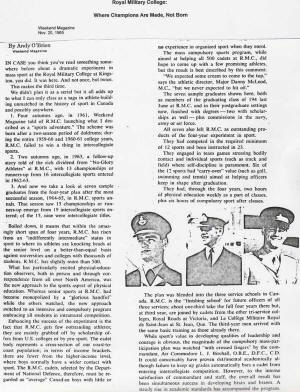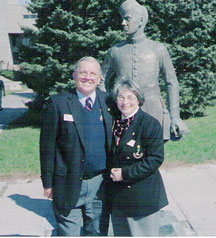|
Doug Hargreaves has been one of the most
recognizable and highly respected figures in
Canadian University Football over the past 40
years. He started his University coaching career
at RMC.
He grew up in Sault Ste Marie, Ontario; attended
Queen’s University in the ‘50s, as an Officer
Cadet, in the University Reserve Training
program (URTP) - a forerunner to Reserve Entry
Training Program (RETP), which many of us are
familiar with today. Even though Doug was in
the Reserve, unlike current day RETPs, his
military occupation was pilot. He earned his
Wings in 1956 and completed a Short Term
Commission with the RCAF. Following his
military tour, he returned to S.S.M. and taught
high school and coached football and a number of
other sports.
A few years in the high school teaching
environment was enough to convince this former
pilot / aspiring football coach that he didn’t
want to do the classroom gig his whole career.
The RCAF was looking for trained pilots again!
When the opportunity was presented to
“re-enlist”; fly and even coach football as part
of his duties, he jumped at the idea.
The perfect dream job.
He spent a few years flying and ended up at RCAF
Uplands. During this time he maintained his
contacts with Major Danny McLeod the fireball
RMC, Director of Athletics who at the time was
leading arguably the best varsity sports program
in Canada. “The Major”, was on the lookout for
a football coach for the varsity Redmen. The two
had been in contact off & on for a couple of
years. Doug was still a pilot. Not a problem.
It took a couple of years but he was able to
“reclassify” his military occupation to Physical
Education Recreation Officer (PERO).
Paperwork does have a way of getting mixed-up.
His first posting message, only 24 hours
following his reclassification to the new PERO
Branch, was to Portage La Prairie as their new
Base Recreation & Sports Officer. Doug almost
had a heart attack!
The RMC Commandant of the day was Air Commodore
Len Birchall. It took Danny McLeod about two
minutes to contact him with the news of the
paper work “screw-up”. Needless to say, with
these two gentlemen involved, it was only a
short time before the “Redmen” had their man.
We have no record of who the person was sent to
RCAF Portage La Prairie to replace the football
coach.
In 1965, F/L Doug Hargreaves, now an ex-pilot
with a passion for football joined the McLeod
athletic department staff which included the
likes of: F/L Hank Tatarchuk; CPO Reg Pit;
Sgt/Major Rick Bourgon; Sgts: Wally Travis; Jim
Gebhardt; Art Vondette; Bob Murray; Bruce Potter
(who left us far too soon); Pos: Tom Walton and
Max McClelland. Definitely an “A” team!
For the first couple of years at the college, he
handled the varsity football team and varsity
athletic administrative duties. A couple of
years later, when the popular and respected
basketball coach, Hank Tatarchuk was posted out,
Doug took on the responsibility of coaching the
basketball team too!
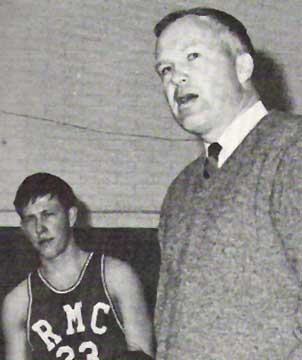 |
Coach Hargreaves is best known as a
football man but he also coached the
RMC varsity basketball team for
three seasons from 1967 – 70. He
took over from his good friend Hank
Tatarchuk who had been posted.
Hargreaves had been both a varsity
football and basketball player
during his days as a student at
Queen’s University (1951-55). He
had also coached both sports at the
high school level in his home town
of Sault Ste Marie, Ontario prior to
re-enlisting in the RCAF. |
The
1960s was one of the most turbulent decades
experienced world-wide. In particular, 1967 was
big for Canadians. It was Centennial Year; RMC
had opened 91 years before; Toronto Maple Leafs
won the Stanley Cup; the City of Montreal hosted
a World Fair (Expo ’67); and the NHL expanded
from 6 to 12 teams. The three Canadian military
arms, the RCAF, the RCN, and the Canadian Army,
would be integrated into the Canadian Armed
Forces by February 1968.
Air Commodore Len Birchall retired from the RCAF
following the RMC graduation.
What else?
Doug Hargreaves, the football coach for the past
two seasons would take on the added
responsibility of coaching the RMC basketball
team.
And.
A young six foot plus, III Year Cadet who just
arrived from CMR with a passion for the game
James Naismith
invented in 1891 was eager to play at the
OSLAA level.
CMR had played
exhibition games
against the RMC "big" team, so he had some
exposure to them under Hank Tatarchuk's coaching
tenure. He also arrived with impressive
personal playing credentials –
leading scorer in the Quebec JV league;
team captain
and had developed / honed his skills
playing under 4033 Dr.
Peter Aichinger
(RMC ‘58) who was a part-time coach and
full-time teaching professor at CMR.
Thirty nine years later, 7855 Paul Hession
(RMC ’69) recalls playing for Coach
Hargreaves. “Our first year, we were 3 - 10.
Doug deserved enormous credit for us turning it
around to 12 – 9 the following season. We wound
up in the OSLAA conference final, which we
eventually lost 71-44 against the Loyola
Warriors (now Concordia Stingers) despite the
fact that we had lost five senior players to
graduation.”
To put it into perspective just how good the
1968/69 Hargreaves coached Redmen were – Loyola
went on to win the CIAU consolation championship
final by defeating U of Alberta 76-66. The only
RMC basketball team able to accomplish similar
results was the Craig Norman coached 02 / 03
squad that lost 71–67 in an OUA quarter-final
play-off game to Ottawa U.
Ottawa U did not advance to the national
championship.
The still fit looking former CMR/RMC basketball
star added, “Doug was a strong disciplinarian
who paid close attention to the technical
details of the sport - focusing on footwork,
responsibilities and positioning. His biggest
coaching strengths were team defense and
conditioning - which kept us in a lot of games
against more talented athletes. When we lost,
his dry sense of humour also helped us to get up
for the next competition.”
Paul also stated, “When
I started to play for Doug, it was obvious that
he had a very "professional" approach to his job
and it was easy to "sign up" for his way of
doing things.”
“My job was continuous coaching from September
to March, in addition to the administrative
side. Fortunately, there was no overlap between
the two seasons at that time. It was a busy
period because “The Major” was helping to create
the CIAU, and I was kept hustling,” recalled
Coach Doug.
Honest and straightforward, Hargreaves seldom
pulled punches, imparting as much character as
he did football / basketball lessons & skills to
the cadets. Sometimes as stern as a drill
sergeant, Doug also had a pleasant habit of
putting aside the military-honed disciplined
manner when necessary.
Jim Simpson arrived at RMC when Doug was
starting his second year as football coach. “In
our recruit year there were very strict team
training rules that were very seriously taken by
the players and coach.” explained Jim who went
on to be a star Redmen quarterback and punter
during his four years at RMC.
He described an incident on the field.
“One Monday afternoon practice, Doug called the
team together to introduce the day's practice
routine as he did every day we were on the
field. This particular day he called forward two
fourth year starters and challenged them as to
whether or not they had broken training rules
following Saturday's game. They confessed in
front of the team and were dismissed from
practice and the team immediately. This event
crystallized in my mind how dedicated Doug was
to his job and that his expectations were that
if each of us was not in tune with this, we were
not wanted on any team that he coached.
As the years went by, Doug was forced to modify
some of these strict rules as society pressures
changed. However, this single incident has
remained in my mind since that day as an example
of the sacrifice that is required to be an elite
athlete.”
Doug had a lot of assistance while at RMC and he
never misses an opportunity to express gratitude
to former Redmen 6552 John “Mugger” Macko,
Brian Cass, Elliot Jacobsen, his own brother
Ward, and 7296 Dave McCaw (RMC ’68) –…
“All five were key-members of the coaching staff
at various times and contributed greatly to our
success during those years…” acknowledged the
former RCAF Pilot turned PERO. “Dr Al MacKenzie
did a lot of coaching too my first couple of
years, before his medical duties prevented him
from having the time to spare for coaching
duties.”
Both the RMC basketball and football teams were
competitive and represented the college with
class and distinction during his tenure. More
importantly, a “ton” of cadets from his teams
went on to have outstanding careers both in the
military and civilian life. Many of them to
this day are the biggest supporters of the
college and the RMC Club of Canada. A few have
stayed in touch with their old coach. Most are
just a pleasant memory.
“I don’t remember all the guys who assisted us
but the caring hands of Chuck Babcok and Dr. Al
MacKenzie really stick out in my mind for the
great help they both provided in the treatment
of injuries and the like. Game after game,
always going the extra mile for the benefit of
the cadets on our teams,” added Doug as he was
recalling those early RMC days. “I’ll never
forget the effort and commitment we received
from so many fine athletes and their
determination to do well on the gridiron and the
basketball court. We won a number of games on
grit alone.”
During his RMC days as football coach, the
Redmen usually played the best university teams
in the country. Doug Smith recalls, “Coach
Hargreaves, was never adverse to competition, as
in my IV year, we played U of Calgary, U of
Saskatchewan, and University of Windsor in a 10
day pre-season campaign.” Smitty also didn’t
hesitate to mention. “We were two for three in
those exhibitions.”
He recalls many stories and events both as a
player, as assistant and even more as a dear
friend. “Doug always had the greatest respect
for the development of his young charges, and
while he found some of the College policies a
bit trying and counter-productive, he maintained
posture as a firm promoter of RMC and the
military throughout. He was an exemplary
role-model who's love for the game of football
and insistence on fair play "by the rules"
throughout provided character-building for all
of his players.”
All good things come to an end.
In
1970 Flight Lieutenant “Coach” Hargreaves was
posted to CFB Shearwater as Base PERO. By now
the Danny McLeod era was coming to an end at
RMC. Postings for members of the athletic
department “in & out” of RMC were now being
controlled more by Ottawa located Career
Managers. Some people, in the know, would point
to this particular time period in the history of
the college, as the start of the decline of the
RMC sports program. Prior to this, McLeod, with
input from staff members had a big say on who
was posted to the RMC athletic department.
Certainly, no one can dispute the “Where
Champions Are Made, Not Born” period was
over and has never returned in the 35 years
since. See the
Flashback article .
The ever keen F/L Hargreaves, wife Norma and
three daughters; Vicki, Gayle and Lynn moved to
Halifax. He eased himself into the PERO
position. To keep himself busy and to keep his
fingers in the game he loved most, he took on a
volunteer job as the assistant coach with the
Dalhousie University football team. He also
picked-up the pace in pursuing a Masters
program.
Within a few months of arriving at CFB
Shearwater, the keen F/L was promoted to
Squadron Leader and transferred to Command
Headquarters, Trenton, Ontario as Command PERO.
Because of the potential complications
associated with uprooting children three times
in less then a year, Norma and the girls settled
right back in Kingston instead of moving to
Trenton. It turned out to be a very wise
decision.
Doug made the one-hour Trenton / Kingston drive
or so pretty well daily. Of course, with
football being available at Queen’s University,
it didn’t take long for the legendary Frank
Tindall, the gentleman who was his coach during
his playing days at Queen’s from 1951 to ’55 to
contact S/L Hargreaves with an offer to join his
coaching staff as an assistant.
Back to Halifax!
In 1972, he was lured to Dalhousie University –
this time as the Athletic Director and Head
Football Coach.
He quickly “retired” from the (now) Canadian
Forces after 13 years of military service. His
football club struggled through those Dalhousie
years and Doug, being the competitive guy that
he was, took it hard, as he felt responsible.
However, during his four years at Dalhousie U,
the enthusiastic Hargreaves engineered the
rebuilding and strengthening of what had been an
almost non-existent athletic program. Win or
lose on the football field, he was earning a
well deserved reputation as both an athletic
administrator and an outstanding football coach;
he continued to work on his graduate degree and
earned a Masters of Science in Physical
Education during this time period.
The dream was
about to get better!
His old coach and mentor, Frank Tindall retired
from Queen’s before the 1976 football season,
Doug was offered the head coaching position and
to teach in their School of Physical Education.
Doug, Norma, Vicki, Gayle & Lynn packed their
suitcases one more time and headed back to
Kingston.
Success didn’t take long! In two years, his
Queen’s Golden Gaels team won the Canadian
College Bowl, defeating UBC 16 – 3 in a game
played before 19,124 excited spectators at
Varsity Stadium in Toronto. The Golden Gaels
were the first undefeated team to achieve that
goal.
|
Doug always found a way to assemble
first-class coaching staffs. Two
RMC 1969 classmates who later
attended Queen’s University and
completed their MBAs were part of
his 1978 National Championship
staff.
(Left) John Carlson and Doug Smith
long after their coaching days,
enjoying a round of golf.
(click on picture for larger view)
|
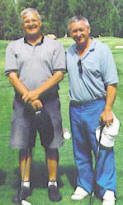 |
RMC fingerprints were all over the success
of this national winning Queen’s team.
8469 Jim Simpson (RMC ’70) helped coach
the Gaels Quarterbacks for two years prior
to 1978. 8074 Doug Smith (RMC ’69)
was in charge of the Defensive Backs; and
8019 John Carlson RMC (’69) controlled
the Linebackers. These three Ex Cadets while
completing individual MBA’s and made
significant contributions which Coach
Hargreaves would mention (often over the
years) …” they were important cogs in the
coaching machine…”
Outside Norma and the three girls, Doug
Smith, probably knows and admires Coach H
more then anybody else. As mentioned
earlier, Doug played for him at RMC from
1965-68. Smitty was the Redmen team captain
and earned All-Conference Half Back honours
in his IV year as a cadet.
The former speedy RMC Half Back was also
part of the Queen’s football staff from 1977
to ’81. During that period the Gael's won
four conference championships, three trips
to the Atlantic Bowl and one to the Yates
Cup. For the uninformed, all four Bowls were
for the Eastern Canada Title; and, as
mentioned, they won the National Collegiate
Title with the ’78 impressive 11-0 season.
Smitty went on to tell us, “The years at
Queen's with Doug were a continuation of his
high standards and principles, as well as
his dry humour, all contributing greatly to
the Gael's almost-dominance in that era.
Doug loved it, following-on in the footsteps
of his former coach Frank Tindall.”
Coach Hargreaves ended up the most
successful football coach in Queen’s
history. During his 18-years at the helm of
the Golden Gaels, Doug’s teams reached the
playoffs for 16 consecutive seasons. He led
Queen’s to nine conference titles and two
national championships. By the time he
retired in 1994, he had coached more
university football games than anyone else
in Canada: 233 - with 109 wins to his
credit.
|
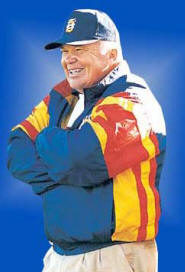 |
In 1976, Coach Hargreaves returned
to Queen’s University football and a
teaching position. He took over
from the legendary Frank Tindall who
had just retired.
The Hargreaves led Gaels would win
two national titles (Vanier Cup) and
several other league championship
before he retired in 1994.
Doug was widely known as an
exemplary role-model who's love for
the game of football and insistence
on fair play "by the rules"
throughout provided
character-building for his players. |
He capped it off, at the Sky Dome in front of
28, 645 fans in 1992, with that second National
Championship, - which by now was called the
Vanier Cup, Canada’s University Football
Championship. His Queen’s team shut out St.
Mary’s 31 - 0, another first for the Vanier Cup.
Over the years he earned many “Coach of the Year
“ honours. Including three different times (’83,
’89 & 91) in the former Quebec / Ontario
Intercollegiate League which Queen’s competed in
for many years. He also took the top coaching
laurels in the OUAA on two different occasions
1977 & ‘79.
Capturing individual trophies was never
important to Doug, however, winning - The Frank
Tindall Award, which is given annually to the
top intercollegiate football coach in Canada in
1983 meant a little extra. He had a special
reason to be proud it was after all named after
his former coach from his playing days and later
his mentor. He served on Frank Tindall’s staff,
which made those daily-commuting trips between
Trenton and Kingston back in 1971 extra special.
In addition to winning a great deal of team and
individual hardware over the years, Queen’s
University honoured him in 1992 by naming an
athletic award in his name - The Doug Hargreaves
Trophy,
awarded annually to the Most Outstanding
Offensive Player.
He continued to live his dream, all over the
world.
Doug Hargreaves did more for the game of
football then play and coach for a particular
school. He served on the CIAU Rules Committee
for 10 years, and he was also a member of
Football Canada Coaches’ Working Committee which
created the Coaching Technical Certification
program for Canada. He also was a pioneer in
exporting the game to various parts of Europe
(Switzerland and the Netherlands) teaching,
coaching, and developing Canadian football.
To say he loved: talking, coaching, and
promoting football would be an understatement!
He is now a member of the Kingston District
Sports Hall of Fame
and since his retirement from football coaching,
Doug and Norma spend their winters in Invermere
BC, skiing at Panorama…”right now my body is
going downhill faster than I can ski” says Doug
with that ever present twinkle in his eyes.
Doug had an advantage over most of his peers in
the football coaching business in that Norma,
(they just celebrated their 50th this
past January) and their three daughters were
always his biggest supporters. John Macko
remembers his IV year as a cadet, which
coincided with the arrival of Coach Hargreaves
at RMC. “His wife was just as much a fanatic as
he was. In fact his three kids who were all
girls were also his best supporters,” John
recalls. “Later when I was helping out as an
RMC assistant coach it would not be unusual to
see Mrs. H and all three girls tugging along
after her in and around the practise field.”
About 11 years ago, Doug Smith, organized a
Dinner (roast) at RMC to honour his former coach
and mentor. Ex Cadets and former Queen’s
players from all over the globe formed the
majority of the large crowd in attendance. As
one would imagine, the stories and laughs flowed
for hours.
Jim Simpson myth exposed!
When it was noted that Jim Simpson, had won the
League punting title, Coach Doug reminded
everyone that those booming spirals off - of
Jimmy's foot averaged out well, as the coach
"only let him punt when we had the wind.”
It brought back memories of when Doug was asked
by a keen Whig Standard reporter, for the
season’s forecast - Coach Hargreaves replied,
we’re small, but we’re slow”. And who could
ever forget his dry humour, following some tough
questions from the same scribe following three
consecutive Redmen losses. Says Coach Hargreaves
of his teams’ losses: “Football is a game of
mistakes, we just make more mistakes than our
opponents.”
Between high school teachings, Air Force pilot,
coaching university football & basketball and
helping to raise three daughters, Doug found
time for outside endeavours. He has taught Adult
Sailing around Kingston and is still heavily
involved - “building, flying, crashing and
repairing radio controlled model airplanes. I
received the “Crash of the Year “ trophy twice,
and I’m having a ball,” smiled Doug while
sharing a coffee / tea / & a few stories with
old friends and colleagues Danny McLeod and Jim
Gebhardt.
Now 74, he looks back over these 40 years with
some great memories; he had the opportunity to
turn a 13-year military career into a full-time
love affair with university football coaching.
“I met a lot of fine people by the time that I
retired from Queen’s in 1994. Never had a
football player that I wouldn’t invite home in
my entire career.”
To think, his dream job started at RMC over 40
years ago.
Continued good health and happiness to you and
Norma in your retirement years, Coach.
Doug Hargreaves may be reached at
hargreav@post.queensu.ca |
![]()
![]()
 You
should have your own RED Credit Card - special rates for RMC
Alumni
You
should have your own RED Credit Card - special rates for RMC
Alumni![]()
![]()
![]()
![]()
![]()
![]()
![]()

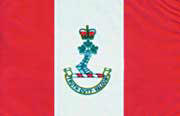


 Looking for a
great Executive Pension Plan? Visit
Looking for a
great Executive Pension Plan? Visit
